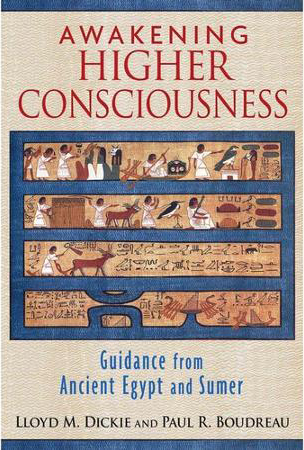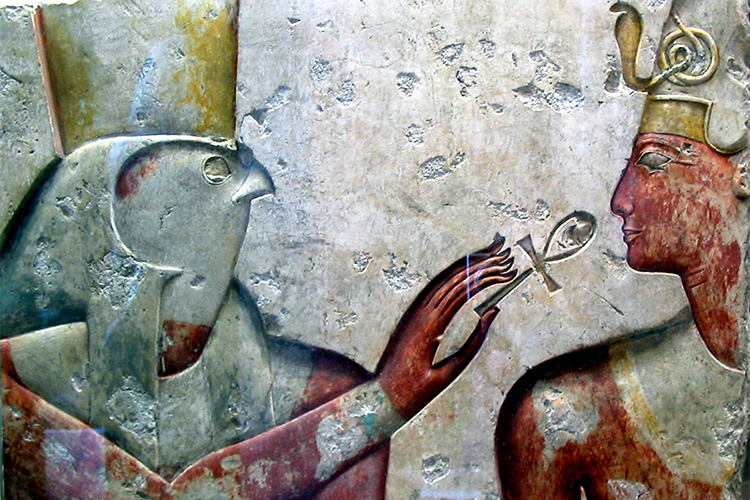 Awakening Higher Consciousness:
Awakening Higher Consciousness:
Guidance from Ancient Egypt and Sumer
Lloyd M. Dickie and Paul R. Boudreau. Inner Traditions
(www.innertraditions.com), 2015. PP. 246. $18.95 Paper
Reviewed by James George and Francis Childe
When two ecologists and biologists, who have spent a year together exploring the wisdom hidden in ancient Egyptian temples, decide to share their discoveries about awakening higher consciousness, they face two problems, even when they are friends and come from the same city—in this case, Dartmouth, Nova Scotia. To maintain their academic standing, they must present solid rational evidence that there is any such reality as higher consciousness, and that, at the dawn of civilization, our remote ancestors may have understood a more subtle level of reality better than we have.
The second problem they face is to find a common way of expressing their individual discoveries. Co-authorship is never easy, but these two have nevertheless managed to produce a truly remarkable study.
In their introduction, Lloyd Dickie and Paul Boudreau, both credentialed scientists, recall Arnold Toynbee’s insight—that in a “time of troubles” like ours, ancient myths can help in the search for a better sense of the meaning of life, of the Self, or of higher consciousness. For, as our authors affirm, “ancient myths contain the oldest expression of who we are….
“We in the West can trace our cultural roots directly to myths written down 4,500 years ago! But the challenges modern societies face lie in understanding what these myths are telling us and determining how we can make use of them in our everyday life to awaken our higher consciousness….
“The primary purpose of the myths is to urge us to awaken. The wonder is that they seem to be so difficult to hear. The myths also speak of the need for struggle…. They repeatedly point out that the real evil for us is isolation and the separation of parts. Using symbolism, they also show that under the ordinary circumstances of life the desire for individuality leads to isolation. When one’s desire becomes the opposite of what is needed to achieve wholeness, transformation is blocked. Isolation leads to enmity and division, while integration leads to positive relationships and wholeness. The struggle in life is the work of embracing and reconciling opposites: love-hate, joy-sadness, hope-despair, and so forth…. So … we hope that our readers will see these myths in a new light that will contribute to their explorations of themselves and the world around them—to help them find and establish a stronger Self within themselves.”
From these extracts, it is clear that this book aims at a new interpretation of what Joseph Campbell called “the Hero’s Journey,” taking advantage of better modern translations of the ancient texts, and of the insights of Schwaller de Lubicz and G.I.Gurdjieff, among others. The “Guidance from Ancient Egypt and Sumer” in the subtitle of the book tells us how we can learn from these ancient myth makers to free ourselves from the ordinary analytical mind, and find the “mind in the heart” that Schwaller de Lubicz speaks of in The Temple of Man. The difference, our authors say, may be “between intuition and thinking, or between induction and deduction.” The interaction between these two minds “is the essence of myth itself.”
This book is not just an academic study about the beginnings of civilization. For Dickie and Boudreau, these “stories of wisdom are not about others, about the dead, or about the past. They are about us, now. The symbolism of Osiris warns that our part in understanding the differences between death and awakening to life can be played only if we maintain an active role in the continuing struggle between preconception and perception. So rapidly are our fleeting moments of clarity destroyed by our habitual, day-to-day preoccupations that we need help to even be more aware of their existence. We need to be fully aware that we are participants in this myth if we are to maintain attentiveness. Only by awakening can we turn towards the possibilities for living as a re-membered being, existing in the everlasting present…. This realization of the need for help to mount the struggle is behind the religious teachings of all ages.”
In this connection, we were glad to learn that the more accurate translation of what we all know as The Egyptian Book of the Dead is The Book of the Coming Forth by Day. Yes indeed; let there be Light! “The Egyptians saw [one’s individual purpose] as becoming united with the light and life-bestowing properties of the eternal sun itself.” In preparing initiates for life after death, by learning to “die before you die,” the priests of Egypt were using esoteric methods that have subsequently entered Greek culture through Empedocles and Pythagoras, early Christianity through the Gnostics, and Sufism through Hafez and Rumi.
Although they recognize these linkages, the authors have said little about what is now known about the detailed practices of breathing with awareness that led the Pyramid Texts to speak of mortals feeding on air, feeding “on the gods’ food, the food on which they feed.” Nor do they connect these practices with the development of higher being bodies that may not die when the physical body dies. Yet there are many cases where the ankh of Eternal Life is associated with the ka or soul in a ladder of possible transformations. They take sahu (astral body) as meaning just “our biological germ plasm.” We think it was much more than that, and are including in this review a striking image of Horus, the New Man, “the one born not of flesh but of spirit,” initiating a pupil (symbolized by the pharaoh) into the absorption of the higher elements in the air—“the gods’ food”—in what Gurdjieff believed were esoteric schools of repetition.
Coming from a scientific background themselves, the authors share their amazement in discovering, through Giorgio de Santillana and Hertha von Dechend’s Hamlet’s Mill, that the earliest Egyptian architects were using the sophisticated mathematical ratios of pi and phi, and their astronomers were fully aware of the precession of the equinox, long before the Europeans were.

We have concentrated on the Egyptian parts of this great book, but our authors have done a great job in discovering many parallel themes in the traditional stories of Sumer, Akkadia, and Babylon, as well as in the magnificent epic of Gilgamesh. So readers of this book have much to look forward to and enjoy, even when some parts may seem heavy going.
We suspect, as co-reviewers, that our co-authors have sometimes solved their differences of view by putting both their versions into the book, and this may explain the redundancies. But this is a minor problem and perhaps in the end we would do well to take note of what no less an authority than Gurdjieff says about the ancient tales and myths. Writing of his own experiences as a boy listening to his father recount the legend of Gilgamesh, he says: “When the beneficent result of the impressions formed in my childhood from the narratives of my father finally became clear to me—a result that crystallized in me a spiritualizing factor enabling me to comprehend that which usually appears incomprehensible—I often regretted having begun too late to give the legends of antiquity the immense significance that I now understand they really have.”♦
James George is a former Canadian Ambassador (to India, Iran and the Gulf States, Nepal and Sri Lanka). He is the author of Asking for the Earth: Waking Up to the Spiritual/Ecological Crisis (1995) and The Little Green Book on Awakening (2008). He lives in Toronto.
Francis Childe is a historian and former United Nations diplomat who has undertaken extensive research on ancient spiritual traditions, including those of Egypt, Mesopotamia, and Central Asia. He lives in Paris.
